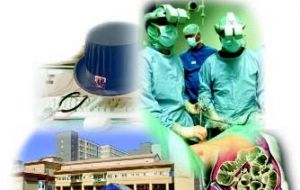MercoPress. South Atlantic News Agency
Uruguay's “double risk”: inflation or exports incentive loss
 “Health and medical care” pushed the January CPI
“Health and medical care” pushed the January CPI Uruguay's consumer prices index, CPI increased 0.78% in January, below expectations but the largest monthly rise since last August, 1.73%. January's CPI a year ago was 1.77% and in 2006, 1.37%. The last twelve months CPI now stands at 7.44%, still above the 3 to 7% Central Bank target.
However Uruguayan financial authorities face a complicated scenario since the Uruguayan currency, Peso, following global patterns, has steadily appreciated eroding the country's export competitiveness. Therefore raising the Central Bank reference interest rate to help combat inflation could further plunge the US dollar and thus further threaten exports profits margins. Nevertheless Uruguayan authorities believe that in the second half of the year inflationary pressures given the sustained activity since 2003 will necessarily force the bank to raise interest rates. The gap between the basic rate determined by the US Federal Reserve and the local Central Bank determines the inflow of foreign capital and dollar liquidity in the local money market. A local analyst from Tea Deloitte, Pablo Rosselli believes the Uruguayan economic team faces "a double risk". Inflationary pressures on the one side which demands contraction, and neutralizing distortions to the exchange rate, but he believes "there's margin to wait and see how events evolve in February and possibly March". Among the factors that had a positive impact on January's CPI is precisely the US dollar 2.4% depreciation (with its impact on imported or similar "transable" goods) and the fact that the government did not adjust public utility rates as is common in the first month of each year. This has meant that prices related to imports only increased 0.13% compared to those "non transable" --such as the administrative price of utility rates, education, housing-- which jumped 1.15% in January. Subjacent inflation which does not include volatile items such as fuel and food in January was 0.92%, and in the last twelve months 6.83%. As to the items which pushed the January CPI, the Uruguayan Statistics Office report shows there was prevailing influence from "health and medical care", 2.5%; food and beverages, 0.79% and as sub-items bread and cereals, 1.6%; cooking oil and grease, 2.5%. However in the last twelve months vegetables take the lead with an 83% increase, basically because of the very adverse climate conditions in winter and spring. Regarding the money exchange market, the US dollar so far in 2008 has experienced an 3.18% depreciation against the Uruguayan peso, having fallen below the rate of 21 pesos to the US dollar for the first time since July 2002, which is no incentive for exporters. Meantime wholesale prices jumped 1.1% in January and 15.27% in the last twelve months. In January 2007, the increase was 1.8%.




Top Comments
Disclaimer & comment rulesCommenting for this story is now closed.
If you have a Facebook account, become a fan and comment on our Facebook Page!